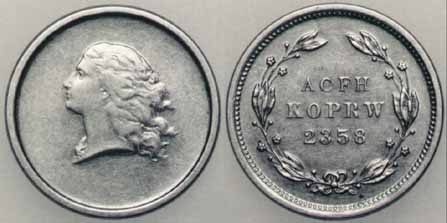|
|
EXTREMELY RARE & IMPORTANT
EXPERIMENTAL ONE CENT PIECE
UNDATED experimental one cent piece. If not struck at the U.S. Mint itself then undoubtedly struck by a private firm at the mintís direction, possibly from mint prepared dies. The goal of this experiment may have been the developement of a new type of coining press and/or metal alloy for use by the U.S. government. The obverse has a plain border with a head of Liberty, facing left, with flowing hair. The design is very similar to the famous Libertas Americana medal, lacking the Liberty Cap and pole, originally designed by Augustin Dupre' near the end of the eighteenth century. Of American coins the device most resembles the 1792 disme. The reverse appears to be a wreath of cotton tied with a bow of ribbon at the base all within a denticled border. Inside the wreath is the nonsense legend in three lines: ACFH / KOPRW / 2358. This plain edge piece is approximately the same thickness as a U.S. penny, weighs 2.8 grams, is 19mm (.748 inches) in diameter and struck in a steel alloy. This last is indicated by a specific gravity of 7.657, the fact that it is highly magnetic and steel in color. The die alignment is the same as a U.S. coin although the reverse is positioned off 20 degrees in a clockwise direction. These dimensions and properties compare closely with the 2.7 grams and 19mm diameter given by Yeoman in his Guide Book of U.S. Coins for the 1943 zinc coated steel cents and form the basis for our conjecture that this interesting coin was intended to be a cent. Sharply struck, about uncirculated condition with some original mint luster remaining. We note two light rust spots in the reverse field over AC and below right ribbon end which serve to identify this specimen. A very important coin and currently the only specimen we know of. Unlisted in the recent Pollack book on U.S. pattern coins.
$3495.00.
The composition of this piece suggests that it originated during World War II when the U.S. Government was searching for alternative metals to replace the copper used in U.S. coinage, particularly the cent. In spite of this, we think it is far more likely that this coin had its orgin in the early 1960ís during the coin shortage in this country. At that time General Motors was experimenting with the manufacture of a roller press to dramatically increase coin production for the U.S. Mint.The reverse die closely matches the known General Motors roller pennies in the composition of the wreath and includes the same three lines of nonsence legend. The most notable differences are another, smaller line of nonsense, the addition of the letter G and the lack of reverse denticles around the border.This very interesting and important experimental cent resurfaced at the January, 1995 FUN Convention in Orlando, Florida. Prior to its rediscovery, this identical specimen (identifiable by the above mentioned rust pits) was last reported on page 1070 of the May, 1980 issue of the Numismatist where it was pictured. A photo of a similiar piece was submitted by Albert Kramer of New York City and published in the May, 1962 Numismatic Scrapbook Magazine on page 1295. That coin was perhaps struck from the same obverse die but had an entirely different reverse. Both reverses had the same numerials, 2358, but the wreaths differ as well as the border treatment and nonsence legend The whereabouts of that piece is unknown, as is its composition and vital statistics. Other similar General Motors roller pieces, commonly referred to as "pennies", were struck from different obverse dies and are occasionally encountered at coin shows and in auctions. The above specimen is significant because it was struck from different dies than the "pennies" as well as a completely different composition. The piece is unlisted in the recent Pollack book on U.S. pattern coins which features such pieces in an appendix.

|



